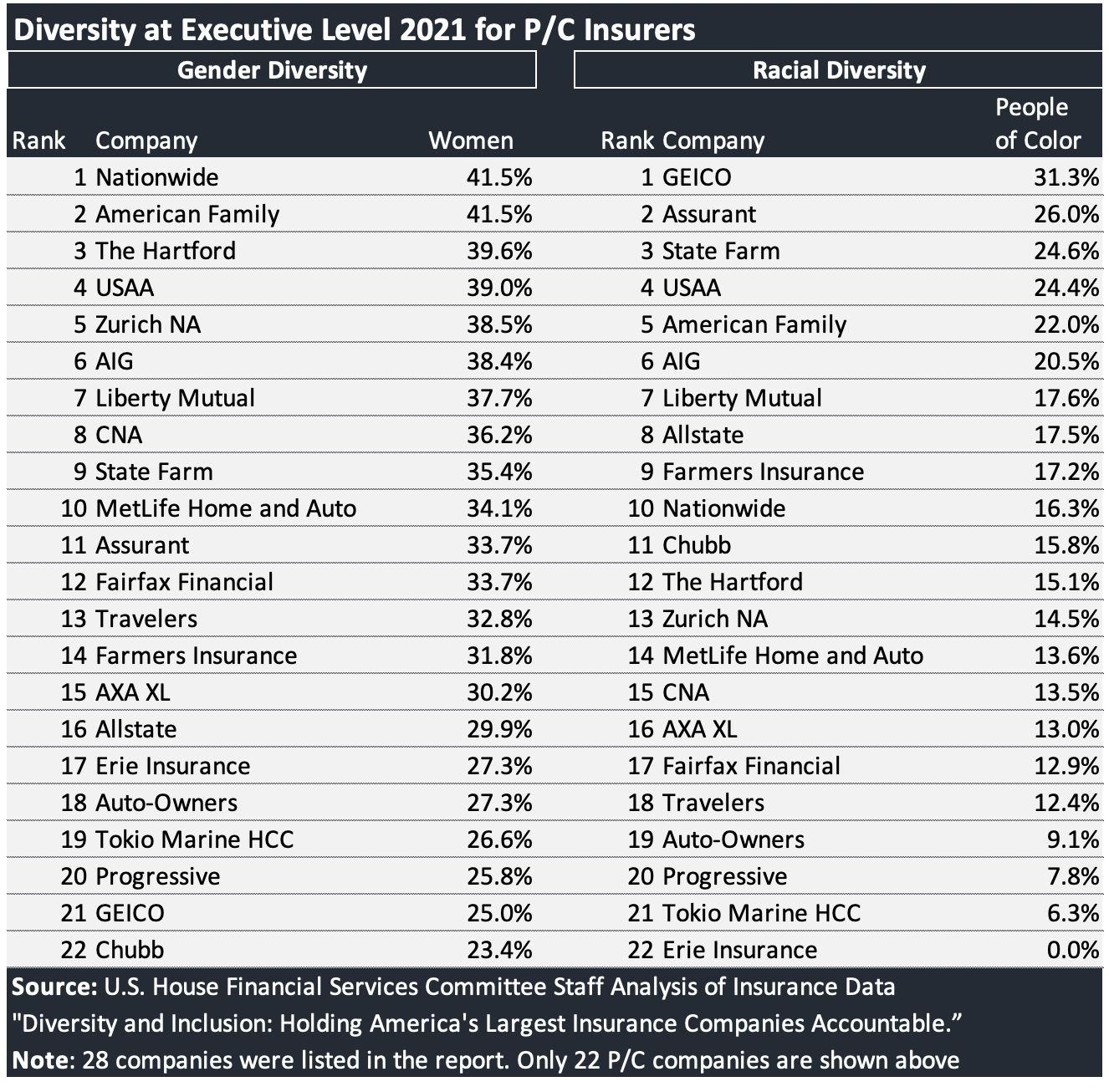The insurance industry still has a lot of work to do when it comes to diversity, equity and inclusion. In fact, despite a strong DEI push across the industry, there was little change in racial, ethnic and gender representation among employees at the largest U.S. insurers between 2017 and 2021, according to a new report from the U.S. House Committee on Financial Services.
Women and people of color are still encountering a glass ceiling at the executive level, and individuals with disabilities are severely underrepresented in the industry, the report found.
The report was released by Congresswoman Maxine Waters, D-Calif., chairwoman of the Committee on Financial Services, and Congresswoman Joyce Beatty, D-Ohio, chair of the Subcommittee on Diversity and Inclusion. The goal of the report is to “examine and resolve the systemic and economic exclusion of women, people of color, persons with disabilities, LGBTQ+ individuals, veterans, and other members of our society who have to fight for a seat at the table.”
The Committee requested data from insurance companies that received direct premiums of $7 billion or more (27 insurance companies total) to report and comment on their diversity and inclusion data and practices from 2017-2021. The request included six categories of quantitative data: workforce diversity, executive leadership diversity, CEO diversity, board diversity, supplier diversity, and investment of assets. In addition, firms were asked qualitative questions related to internal diversity and inclusion policies and practices.
Rep. Beatty called the survey results disappointing during her opening remarks at a hearing on Tuesday. She also noted in her opening remarks that none of the insurance company CEOs who had been invited to speak at the hearing had agreed to do so.
“Let the record show that I am going to invite all 27 CEOs to meet on Zoom with me,” Beatty said.
By the Numbers
Women comprised 54.6 percent of the overall workforce at the largest U.S. insurers in 2021. Only two companies surveyed had fewer than 50 percent of their total workforce comprised of women in 2021: Northwestern Mutual (47.9 percent) and AXA XL (46.9 percent).
Representation of women is concentrated at the lower level and drops significantly the higher you go up the corporate ladder—77.2 percent of administrative support employees identified as women compared to 33.5 percent at the executive level and 28.5 percent at the board level.
Although no companies achieved gender parity at the executive level, Nationwide Insurance and American Family Insurance came the closest, each with 41.5 percent of executives identifying as women. Chubb was the furthest from parity with 23.4 percent of executives identifying as women.
The report found that employees of color had a similar problem.
In 2021, 30.5 percent of all employees at the participating insurers were people of color—this is compared with 42 percent at big banks, 40.6 percent at big investment firms and 42 percent in the general population, according to the report. However, only 16.2 percent of the employees at the executive level were people of color; about 7 percent were Asian, 4.6 percent were Black, and 3.1 percent were Hispanic or Latino. At the board level, only 22.3 percent identified as people of color.
The percentage of people of color in the overall workforce varied significantly by company, ranging from a low of 10 percent at Erie Insurance and Auto-Owners Insurance Company to a high of 54.6 percent at Assurant. GEICO had the highest percentage of executives of color (31.3 percent), while Erie Insurance had the lowest percentage (0.0 percent).
The CEOs at the companies surveyed were overwhelmingly white men (88.9 percent) in 2021. Two companies had white women CEOs (Progressive Insurance and Tokio Marine HCC), and one had an Asian man as its CEO (Fairfax Financial). No CEOs identified as LGBTQ+ or as living with a disability.
Just 4 percent of employees at these insurance companies identified as having a disability in 2021, compared to almost 25 percent of U.S. adults who are living with a disability, the report noted.
The average amount of money spent with diverse suppliers at surveyed insurance companies was 2.7 percent with minority-owned suppliers, 2.4 percent with women-owned suppliers, and 1.2 percent with minority- and women-owned suppliers as a percent of overall procurement spend. GEICO reported the lowest numbers, with 0.0 percent spend with minority-owned suppliers in 2021, while The Hartford reported 6.3 percent spend. Meanwhile, when it comes to women-owned suppliers, The Hartford and GEICO reported 0.2 percent spend, while Liberty Mutual Insurance reported 7.3 percent spend.
The budget allocated to diversity and inclusion for insurance companies on average in 2021 was $5.3 million (0.24 percent of the surveyed companies’ average total budget), an increase from an average of $3.2 million (0.13 percent) in 2017.
Beyond the Numbers
However, it isn’t only about the demographics.
“I think insurers understand that this is not about the number of diverse faces at the table but the experience of those individuals once they’re brought on board,” said Leroy Nunery, president of Evolution Advisors LLC and founder and principal of PlūsUltré LLC, who was a witness at the hearing.
“The industry seems to be shifting from an isolated focus—just on recruitment data—to a more inclusive picture of worker experience and programs for retention. But there’s also evidence of growing attention for leadership development, mentorship and retention programs, and increased interest in HBCU recruitment.”
Eloiza Domingo, chief diversity officer and VP of Human Resources at The Allstate Corporation, agreed.
“At Allstate, we use the term inclusive diversity and equity, or IDE, on purpose,” Domingo said. “More than 20 years ago, we turned inclusion into an adjective because diversity is really nothing without an inclusive environment in which to thrive…Our multi-year IDE corporate strategy was built with many stakeholders and focuses on four pillars: business practices, people, culture and community.”
Nunery said that lack of diversity at the C-Suite level is a large part of the problem. “If you don’t have leadership that either represents or can speak to the concerns and issues of diverse communities, it is likely that management inside those companies won’t be held accountable,” he said.
Nunery also said the industry needs to think outside the box to address the lack of diversity and the talent shortage in general. “The way people end up getting hired into the insurance industry isn’t from school. It isn’t from an ad. It isn’t from a recruiter. It’s because of a personal connection or a friend. And that goes for white, Black or anybody else. The industry itself has a brand awareness issue. So, if you want to not only increase the amount of talent but also…the amount of ownership, you’ve got to have sponsorship. You have to have somebody inside but also outside advocating for that cause.”
He noted that companies need to build awareness about the industry, to send individuals out to promote opportunities and even help the community understand insurance as a product. “You don’t have to have an insurance background or any type of designation, quite frankly, to succeed,” he said.
Next Steps
Ann Wagner, R-Mo., cautioned that while she supports voluntary disclosures of DEI data, she has “long opposed mandatory disclosures that create an apples-to-oranges comparison between companies with different missions, goals, locations and resources.”
She also noted that “since each company self-determined their metrics, I don’t think we can really use this data for straight comparison. But it is a starting point to look at what practices work for promoting diversity and what obstacles companies still face.”
The National Association of Mutual Insurance Companies commented on the hearing, noting the P/C industry’s progress in DEI.
“Today’s hearing showed that property/casualty insurers are committed to diversity and inclusion and building a workforce that directly reflects their policyholders and the population of our great nation,” Jimi Grande, senior vice president of federal and political affairs for NAMIC, said in a statement.
“As data provided by the Congressional Research Service at the hearing shows, insurers pay a higher wage than the overall economywide average and employ a higher percentage of women and African Americans than the general working population. Insurers are also looking forward, working with Historically Black Colleges and Universities as well as Hispanic Serving Institutions to recruit the next generation of industry leaders.”
Recommendations from the Subcommittee:
- Insurance companies should regularly collect disaggregated data on their workforce, executive and board diversity, as well as conduct regular audits on pay and racial equity to better understand their current workforce and why employees of color and women are not moving up the pipeline. This data should be made publicly available.
- Insurance companies should partner with historically Black colleges and universities (HBCUs), minority serving institutions (MSIs), and community colleges to build talent pipelines into these organizations.
- Insurance companies should create training academies that educate less-senior employees on job opportunities and match graduates with mentors and sponsors to support their career growth.
- Insurance companies should consider at least one diverse candidate for all executive positions and board positions when there are openings. Diverse candidates may include individuals with a disability, LGBTQ+ individuals, women, and people of color.
- Insurance companies should consider their board membership criteria and selection committee construction to reduce bias in the interview, selection, and appointment processes.
See the full report: “Diversity and Inclusion: Holding America’s Largest Insurance Companies Accountable.” On Sept. 20, the Subcommittee on Diversity and Inclusion also held a hearing to discuss the findings.






















 Insurance Costs, Climate Concerns Factor Heavily in U.S. Home Buying Decisions
Insurance Costs, Climate Concerns Factor Heavily in U.S. Home Buying Decisions  First Atlantic Hurricane Forecast for 2026 Suggests Season Close to 30-Year Norm
First Atlantic Hurricane Forecast for 2026 Suggests Season Close to 30-Year Norm  Why ‘Good Enough’ Is Killing Insurance: The Hidden Cost of Satisficing
Why ‘Good Enough’ Is Killing Insurance: The Hidden Cost of Satisficing  Breaking: Andersen to Replace Zaffino as CEO of AIG on June 1
Breaking: Andersen to Replace Zaffino as CEO of AIG on June 1 





